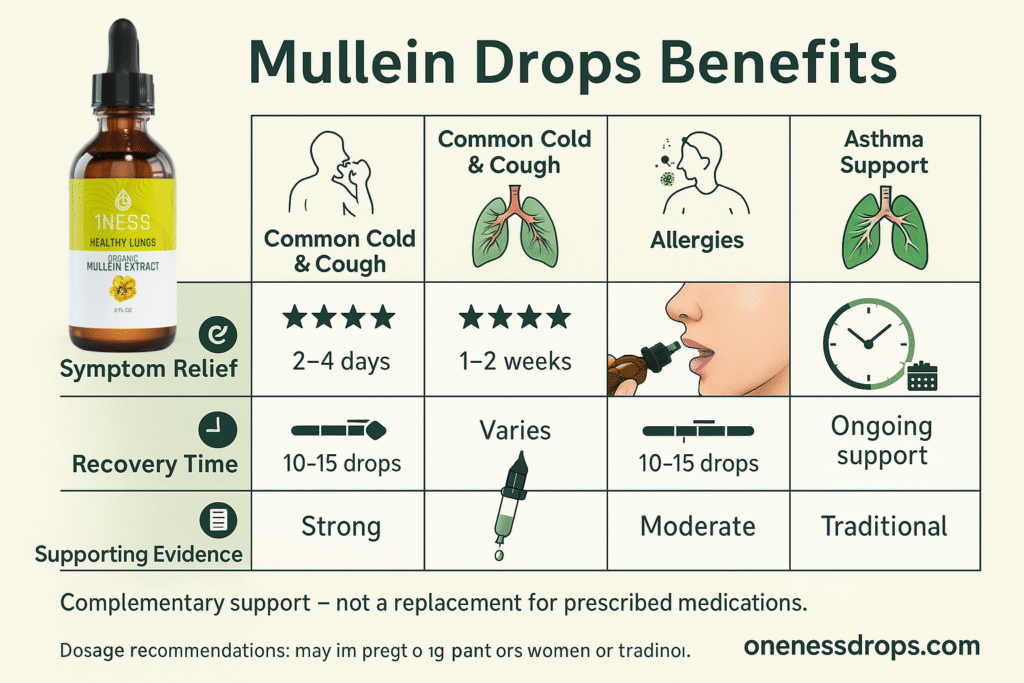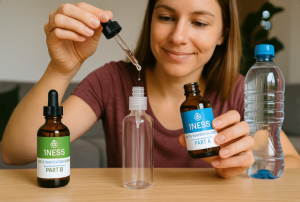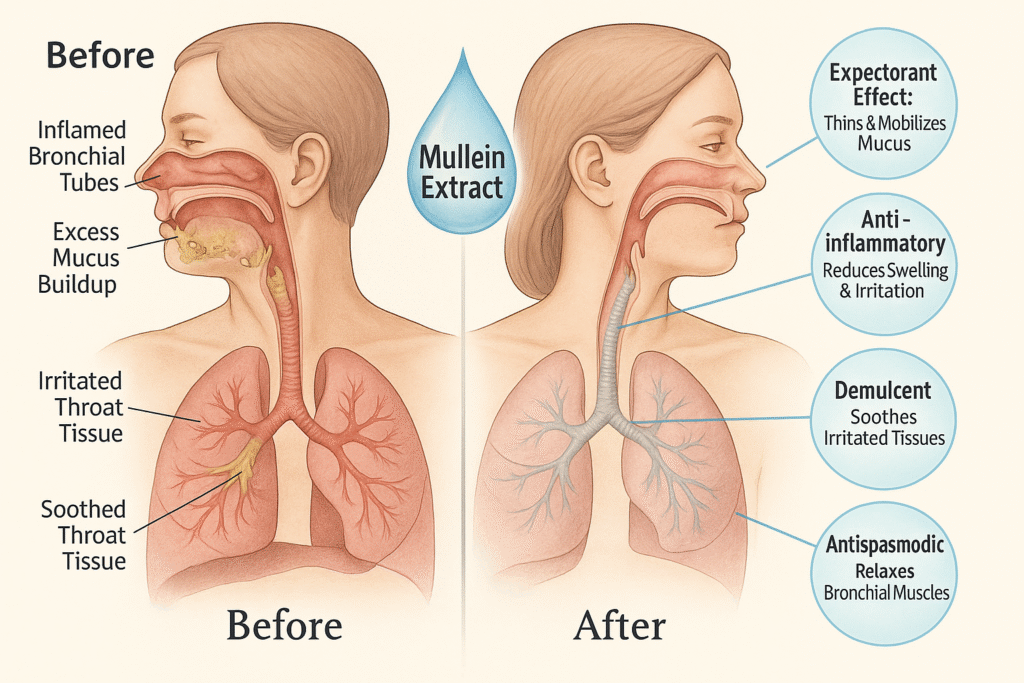Struggling to breathe freely? Mullein Extract offer a time-tested solution for those seeking relief from respiratory discomfort. This potent herbal remedy has been used for centuries to address various breathing issues, from stubborn coughs to congested airways; mullein tincture can help.
Natural lung detox methods are gaining popularity, and mullein drops for mucus clearance stand at the forefront of this movement. Many people are discovering how to use mullein extract effectively for respiratory health, especially during seasonal changes or recovery periods. Unlike pharmaceutical options, these drops work gently with your body’s natural processes to support clearer airways and easier breathing.
Throughout this comprehensive guide, we’ll explore everything you need to know about mullein drops—from their traditional origins to practical usage tips. Whether you’re dealing with occasional congestion or looking for ongoing respiratory support, this natural remedy might be exactly what you’ve been searching for.
What are mullein drops and how do they work?
Mullein drops are potent herbal extracts derived from the flowering plant Verbascum thapsus, which has been used medicinally since ancient times. These liquid preparations harness the plant’s beneficial compounds to support respiratory health naturally.
The plant behind the remedy: Verbascum thapsus
Verbascum thapsus, commonly known as mullein, belongs to the snapdragon family and is part of a genus that includes more than 300 species worldwide [1]. Originally native to Europe, Asia, and North Africa, this remarkable plant later spread to the United States [1].
The biennial plant develops a tall stem reaching heights of 1.2 meters or more during its second year of growth, crowned with distinctive yellow flowers that bloom from June to September [2]. These yellow blooms emit a subtle, honey-like fragrance and, together with the stamens, contain many of the plant’s active medicinal compounds [2].
How mullein drops are made
Mullein drops are typically created through an extraction process that captures the plant’s beneficial compounds. Commercial preparations primarily use the leaves and flowers, which contain a rich array of bioactive substances [3]. These include:
- Polysaccharides that contribute to the plant’s soothing properties
- Iridoid glycosides like harpagoside, harpagide, and aucubin
- Flavonoids such as 3′-methylquercitin, hesperidin, and verbascoside
- Saponins that may enhance expectorant actions
- Volatile oils with various beneficial properties [2]
Manufacturers create these extracts by infusing the plant material in a liquid base. Furthermore, mullein extracts can be alcohol-based tinctures or alcohol-free formulations [4]. The extraction method aims to preserve the plant’s phytochemicals, which possess antibacterial, antiviral, anti-inflammatory, and antioxidant properties [5].
Why drops are preferred over other forms
Liquid extracts offer several advantages over other forms of mullein. First, drops provide superior absorption compared to capsules or tablets, allowing the active compounds to enter the bloodstream more quickly. Additionally, the liquid form makes it easier to adjust dosage precisely for individual needs.
Mullein drops are particularly gentle on the stomach and throat [6], making them ideal for those with sensitive digestive systems. The concentrated nature of drops also ensures you receive a potent dose of the beneficial compounds in each serving.
For respiratory applications specifically, drops can be added to drinks or taken directly, providing a convenient way to support lung health [4]. This flexibility, combined with the concentrated nature of liquid extracts, explains why many herbalists and consumers prefer mullein in drop form for addressing respiratory concerns, including natural lung detox and mucus clearance.
Top 4 respiratory benefits of mullein drops
The healing power of mullein drops extends beyond their historical use, offering specific respiratory benefits backed by scientific research. Let’s examine how this natural remedy supports healthy breathing.

1. Helps clear mucus from the lungs
As a natural expectorant, mullein drops excel at thinning and loosening mucus in the respiratory tract. This action helps break up congestion, making it easier to cough up and expel phlegm from your system [1]. Consequently, airways remain clearer and breathing becomes less labored.
Moreover, mullein contains saponins that specifically help loosen stubborn mucus [7]. This property makes mullein drops particularly valuable for a natural lung detox, as removing accumulated mucus prevents the formation of thick plugs that could potentially block airflow and, in severe cases, lead to lung collapse [1].
2. Soothes throat and bronchial irritation
The high mucilage content in mullein creates a soothing film that coats irritated mucous membranes throughout your respiratory tract [1]. This demulcent action provides immediate relief for throat discomfort and bronchial irritation.
Essentially, mullein drops deliver this coating effect efficiently, calming irritated tissues and reducing the urge to cough [8]. This makes the extract particularly beneficial for those experiencing sore throats or respiratory discomfort.
3. Reduces inflammation in airways
Inflammation in the respiratory system can significantly impair breathing. Mullein drops contain several anti-inflammatory compounds, primarily:
- Flavonoids (including luteolin, quercetin, and apigenin)
- Iridoid glycosides
- Phytosterols
These compounds help reduce swelling in the airways [9], which is particularly beneficial for those with asthma or respiratory infections. Research indicates that mullein’s anti-inflammatory effects may help improve breathing by calming inflamed bronchial passages [9].
4. May support recovery from viral infections
Perhaps surprisingly, studies show that mullein extract demonstrates promising antiviral properties. When tested against the influenza A virus, researchers found that mullein extract showed approximately 50% efficacy [4]. Additional test-tube studies suggest potential effectiveness against certain herpes viruses [10].
Furthermore, mullein contains ursolic acid, which some researchers believe could be valuable in preventing and treating COVID-19 [4]. This compound has been identified as a potential inhibitor of the main protease of COVID-19 [11], although further human studies are needed to confirm these effects.
How to use mullein drops for better breathing
Proper administration of mullein drops makes all the difference in their effectiveness for respiratory health. Understanding the correct dosage, timing, and complementary herbs can maximize benefits while ensuring safety.
Recommended dosage and frequency
Dosage recommendations for mullein drops vary depending on the product concentration and individual needs. Typically, adults can take:
- 1-2 droppers full (approximately 40-60 drops) daily [12]
- 10-20 drops 2-3 times per day [13]
- 40-60 drops (2-3 mL) in liquid, taken 3 times daily [14]
For acute respiratory conditions like coughs or colds, mullein drops are generally taken for 1-2 weeks until symptoms improve [12]. For chronic respiratory issues, a 3-4 week regimen followed by a 1-2 week break is often recommended [12].
Best times to take mullein drops
To enhance absorption, consider taking mullein drops after meals [12]. Alternatively, morning and evening administration helps maintain consistent levels in your system throughout the day.
For those using mullein as a natural lung detox, consistency matters more than specific timing. However, taking a dose before bedtime may be particularly beneficial, as it supports respiratory function while you sleep.
Combining with other natural remedies
Mullein works effectively when paired with complementary herbs. Notable combinations include:
- Thyme: Offers antimicrobial properties that fight respiratory infections
- Eucalyptus: Acts as a natural decongestant to clear airways
- Peppermint: Provides cooling relief and helps ease breathing [13]
Yerba santa, marshmallow, cherry bark, and elecampane can also enhance mullein’s effectiveness for respiratory health [7].
Tips for making your own mullein extract
Creating homemade mullein tincture preserves the plant’s beneficial properties in a stable, long-lasting form. The basic process involves:
- Gathering dried mullein leaves and/or flowers
- Using food-grade ethanol (high-proof alcohol) as the extraction medium [15]
- Allowing sufficient steeping time for proper extraction
For those who prefer alcohol-free options, place the required drops in hot water and let sit for 5-10 minutes—the heat will dissipate the alcohol content while preserving the herbal properties [16].
Firstly, ensure your tincture is well-mixed by shaking before each use. Subsequently, store in a cool, dark place to maintain potency.
Safety, side effects, and choosing quality products
When considering any herbal remedy, safety should be your top priority. Mullein drops generally have a strong safety profile, yet certain considerations deserve attention before incorporating them into your wellness routine.
Are there any known side effects?
Despite its long history of use, mullein drops have remarkably few reported side effects. Most people tolerate this herbal remedy well. Still, some individuals might experience:
- Skin reactions: Contact dermatitis (an itchy rash) can occasionally develop, typically in those with plant allergies
- Throat irritation: The tiny hairs present on mullein leaves may irritate your throat if the product isn’t properly strained
“If it’s diluted, though, it doesn’t typically cause any side effects,” notes one medical professional. “To date, there are no reports of negative reactions or toxic side effects of mullein” [1].
Who should avoid mullein drops?
Certain individuals should exercise caution or avoid mullein drops entirely:
- Pregnant and lactating women: Information regarding safety during pregnancy and breastfeeding is lacking [2], so avoidance is recommended [17]
- Children under 12: Not recommended without medical supervision due to potential allergy risks [17]
- People with plant allergies: Those sensitive to plants in the snapdragon family may experience reactions [17]
- Individuals with broken eardrums: Especially relevant if using mullein oil for ear applications [17]
- People with liver conditions: Due to mullein’s coumarin content, those with jaundice, hepatitis, or other liver diseases should avoid use [17]
How to identify high-quality supplements
Undoubtedly, the biggest safety concern with mullein drops relates to product quality rather than the herb itself. Since herbal supplements aren’t subject to the same rigorous FDA testing as medications, quality varies widely.
Look for manufacturers that invest in independent verification. Reputable brands often provide:
- Certificates of Analysis (COA) documenting product testing [18]
- Third-party testing results confirming purity and potency [18]
What to look for on product labels
Besides price and brand reputation, examine product labels carefully for:
- Quality seals: CGMP (Current Good Manufacturing Practice) and USP (U.S. Pharmacopeia) certifications indicate adherence to quality standards [5]
- Dietary information: Check if the product meets your needs (gluten-free, vegan, etc.) [3]
- Ingredient transparency: Full disclosure of all ingredients, not just “proprietary blends” [19]
In fact, many experts recommend consulting with a healthcare provider before starting any herbal supplement, including mullein drops for natural lung detox or respiratory support.
Conclusion
Mullein drops stand out as a powerful natural ally for respiratory health through centuries of traditional use and mounting scientific evidence. Throughout this guide, we’ve explored how this remarkable herbal remedy works to clear mucus, soothe irritated airways, reduce inflammation, and potentially fight viral infections. Most importantly, mullein offers these benefits without the harsh side effects often associated with conventional treatments.
Despite its potency, mullein remains gentle enough for many people when used properly. The key lies in finding high-quality products from reputable manufacturers who prioritize purity and potency. Certainly, those with specific health conditions, pregnant women, and young children should consult healthcare providers before beginning any herbal regimen.
For those seeking natural lung detox solutions, mullein drops deserve serious consideration. Their versatility allows for customized usage—whether addressing acute respiratory discomfort or supporting ongoing lung health maintenance. After all, breathing freely represents one of our most fundamental needs for overall wellness.
The next time seasonal changes, environmental irritants, or respiratory discomfort challenge your breathing, remember this ancient botanical remedy. With proper usage and quality sourcing, mullein drops might become your go-to solution for clearer airways and easier breathing naturally. Your lungs will thank you for choosing this gentle yet effective approach to respiratory care.
References
[1] – https://health.clevelandclinic.org/mullein-benefits
[2] – https://www.drugs.com/npp/mullein.html
[3] – https://www.herb-pharm.com/products/mullein-blend?srsltid=AfmBOorQNqra30nk5eLeOnvFGxvIkNrZMpNaXOxqtynanVrYMtB9Gb2H
[4] – https://www.verywellhealth.com/the-benefits-of-mullein-89575
[5] – https://www.healthline.com/health/mullein-leaf
[6] – https://nutra-harmony.com/products/mullein-drops-for-lungs?srsltid=AfmBOooo0fvXakNGxH_qFh4QrjfLXzgtyTHrKdcPEkDXLV0X0FBgYWsw
[7] – https://www.ebsco.com/research-starters/complementary-and-alternative-medicine/mulleins-therapeutic-uses
[8] – https://www.webmd.com/diet/health-benefits-mullein-tea
[9] – https://www.medicalnewstoday.com/articles/mullein-for-asthma
[10] – https://www.healthline.com/nutrition/mullein-tea
[11] – https://pmc.ncbi.nlm.nih.gov/articles/PMC8301161/
[12] – https://nutra-harmony.com/blogs/news/mullein-extract-for-respiratory-health-reviews-studies-and-dosage-tips?srsltid=AfmBOopspPsTmdHu2sTHzxmxgIBxYhyt6SEPKhHMOgFHkW2y8D91_j_n
[13] – https://www.regalabs.com/how-to-use-mullein-for-lungs
[14] – https://www.herbalist-alchemist.com/shop-products-mll-mullein-extract?srsltid=AfmBOoopc_egwNLWHJ10kpcZ2DdC6LQqdaxryq4dzs3XrMz7ouRl0byj
[15] – https://culinarysolvent.com/blogs/alcohol-for-herbalists/homemade-mullein-tincture-and-extract-recipe-using-food-grade-ethanol?srsltid=AfmBOorLVQVoZ4SiDfF7iK6vm-q3hS6kMlRs2RQOhSPBB9CumW0uoPwK
[16] – https://realfoodrn.com/mullein-tincture-benefits-and-how-to-make-it/
[17] – https://www.botanical-online.com/en/medicinal-plants/mullein-contraindications
[18] – https://doublewoodsupplements.com/products/mullein-leaf-extract
[19] – https://www.everydayhealth.com/diet-nutrition/mullein-leaf/guide/




